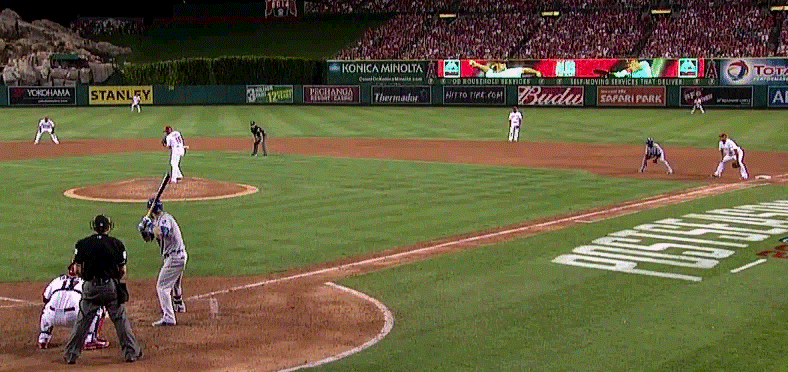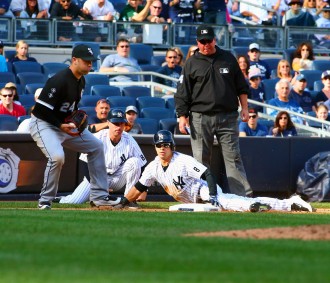The Yankees aren’t the fastest team in the MLB (that title belongs to the Reds), but New York’s roster is comprised of at least a few fleet-footed players. Sure, Brian McCann has been recorded as one of the slowest runners in the majors (by Statcast, he runs 16.07 mph, the slowest in baseball by quite a bit), and if A-Rod or Mark Teixeira try to steal another base, they might disintegrate, but with the dual threat of Jacoby Ellsbury and Brett Gardner at the top of their lineup, the Yankees would be foolish not to be active on the base paths. Surprisingly, the Yankees rank 25th in the league in stolen bases and 21st in stolen base attempts. The team’s activity on the bases has fluctuated all season. Interestingly, some of the Yankees’ slowest runners—not the fastest—have had the biggest impact in the team’s steals.
While the rate of stolen bases for the Yankees seems to be relatively random, the Yankees’ power hitters, such as Brian McCann, A-Rod, and Teixeira, have actually been the driving factor in the team’s activity on the basepaths. It appears that the Yankees and Joe Girardi have tailored the team’s base running strategy to the performance of New York’s power hitters.
| Month | SB | SBA | OPS | ISO |
| April | 16 | 23 | 0.741 | 0.181 |
| May | 14 | 17 | 0.710 | 0.153 |
| June | 7 | 8 | 0.801 | 0.185 |
| July | 3 | 7 | 0.817 | 0.198 |
| August | 8 | 12 | 0.708 | 0.151 |
| September | 13 | 16 | 0.700 | 0.161 |
As you can see, the team starts off 16-23 and 14-17 in stolen bases. Seemingly out of nowhere, though, the team’s stolen base attempts sharply drop. This continues through July and August, before the team starts to steal some more bases in September. The best way to explain this trend is that when the Yankees’ power hitters are performing well (as indicated by the elevated OPS and ISO), Joe Girardi decides to let them ‘do the work.’ He’s trying to avoid a situation where, say, Brett Gardner walks, tries to steal second, and is thrown out. Then Teixeira comes up, and hits a home run. If Brett Gardner had stayed put, it would have been a two-run home run over a solo shot. This approach works the other way too. When Yankee hitters are struggling to hit home runs and score runs, Girardi allows his fast guys to manufacture runs through activity on the basepaths. It’s not a coincidence that when the Yankees’ OPS and ISO are highest, their stolen base attempts are lowest, and vice-versa.
These numbers don’t explain everything, though, as there are a couple of other factors contributing to the Yankees’ stolen base numbers. The first of which is Jacoby Ellsbury’s injury. If he had not been injured, the Yankees would have likely stolen some more bases. Ellsbury missed all of June, and the team was careful with him in July. These two months ended up being the Yankees’ slowest periods in terms of stolen bases and stolen base attempts. (Although he would have bumped up the team’s totals a bit, the correlation still would have existed. For example, Brett Gardner attempted 15 steals through the first two months, but only three through June and July.) At the end of the year, the Yankees weren’t hitting for as much power, yet they were stealing quite a bit. This outlier can be explained by Rico Noel, who I’ll talk more about later. He was 5-5 in stolen base attempts in September.
Joe Girardi had a clear plan of action on the bases, and his strategy makes sense in theory. But, this plan may have ended up costing the team more runs than it gained.
| Month | SB | SBA | wSB |
| April | 16 | 23 | 0.1 |
| May | 14 | 17 | 0.7 |
| June | 7 | 8 | 0.5 |
| July | 3 | 7 | -1.4 |
| August | 8 | 12 | -0.5 |
| September | 13 | 16 | 0.9 |
Using Fangraphs’ Weighted Stolen Base Runs stat, which “estimates the number of runs a player contributes to his team by stealing bases,” one can see the effect of stolen bases on the Yankees. Looking at the table, the Yankees’ most active months on the bases created the most runs, while when Girardi kept baserunners quiet, the team’s wSB totals were lowest. There’s no way to know how many runs the team could have lost by players theoretically being thrown out stealing before a home run was hit, but judging by wSB, it looks like Girardi would have been better off letting the team run when they could throughout the year.
The overall results of wSB don’t really reveal anything drastic, with the worst results leading to the Yankees losing 1.4 runs in July, and the best gaining 0.9 runs for September. That being said, these runs can be very important, especially when it comes to the playoffs and single-elimination games, such as the Wild Card game the Yankees will play on Tuesday. A single run can preserve or destroy a whole season. These results, and historical precedent, show that a running team is more likely to generate runs. For example, look at the Royals in the playoffs last season: wreaking havoc on the bases and stealing away some games. Or this year, with the Reds, Blue Jays, Diamondbacks, and Royals all having the most runs created by stolen bases (wSB), while also ranking at the top of the stolen base leaderboard. Even over the past couple of weeks, Rico Noel has stolen just five bases, yet he has already impacted multiple close games. The fact is, Girardi is going to have to unleash his runners this postseason if he wants to gain every advantage he can get. The team would be wise to include Noel on the postseason roster, to be a pinch-running threat. The Yankees, outside of Noel, don’t have much speed off the bench, and Noel can legitimately be a game-changing weapon. To wrap up this article, I’m going to leave you with a GIF of Terrence Gore being a beast on the bases in last year’s ALDS. Hopefully it will inspire Noel and the Yankees’ speedsters to do the same this postseason.

(Photo: Andy Marlin-USA Today Sports)

Faskinating stuff man…I didnt think Noel should be on the WCroster but you convinced me